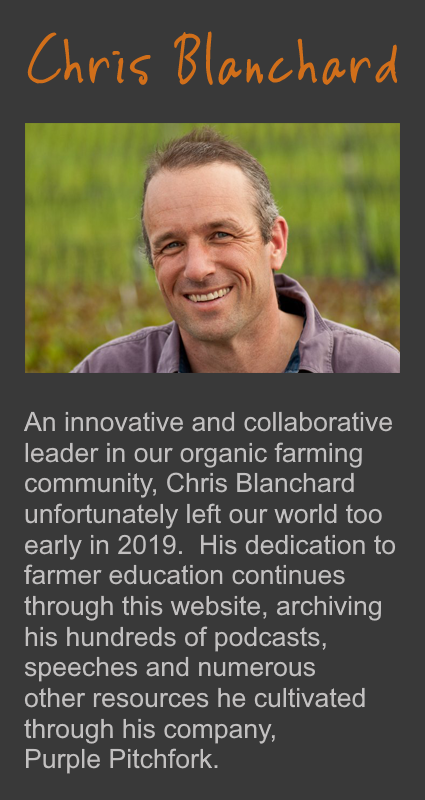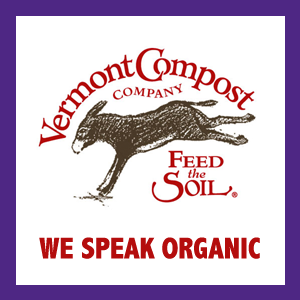If I grow good soil, I can forget about the vegetables. - Nigel Walker
Over the course of the past nine months, I’ve interviewed over thirty farmers on the Farmer to Farmer Podcast, spent a day each on ten different beginning farms, and worked with several experienced growers in different capacities. And here’s what I’ve learned:
It’s not about the vegetables.
Of course, you have to know how to produce the vegetables. Or the chickens, or the cows, or the herbs, or whatever. You can’t get away from needing to know the basics.
And you have to do the work to grow the vegetables.
But one common theme among successful operators has really surfaced: when you put the rest of your world in order, the vegetables (or the chickens) just sort of get in line.
At Angelic Organics, John Peterson builds the soil for two years, uses an easy-to-weed crop to clean the soil, then grows carrots or salad greens that usually don’t require much attention to weeding.
At La Grelinette, J.M. Fortier has used created permanent beds and permanent pathways to reduce compaction, minimizing tillage requirements and driving up yields.
At Tipi Produce, Steve Pincus and Beth Kazmar put employees first, and have almost eliminated turnover in their crew. They don’t spend hours in May teaching employees how to work on a vegetable farm.
At Pleasant Valley Farm, Paul and Sandy Arnold have invested in smart infrastructure that creates high returns and drives costs and inputs down year after year, without taking on a mountain of debt. The farm gets smaller and more profitable every year.
At Spring Hill Community Farm, Patty Wright and Mike Racette have organized their CSA around creating community with their customers, creating a retention rate that approaches one hundred percent (and drives their marketing budget to down near zero).
At Eatwell Farm, Nigel Walker runs his chickens on the cover crops for a year, and gets two full years of practically pest-free vegetable production from the fertility and biological cycling he has created.
At TLC Ranch, Rebecca Thistlethwaite rigorously analyzed the time spent on chores to focus on the most profitable activities.
At Clay Bottom Farm, Ben Hartman cleaned up his work spaces to facilitate the smooth flow of workers and work.
At your farm, what can you do to set yourself up for success?
Over the course of the past nine months, I’ve interviewed over thirty farmers on the Farmer to Farmer Podcast, spent a day each on ten different beginning farms, and worked with several experienced growers in different capacities. And here’s what I’ve learned:
It’s not about the vegetables.
Of course, you have to know how to produce the vegetables. Or the chickens, or the cows, or the herbs, or whatever. You can’t get away from needing to know the basics.
And you have to do the work to grow the vegetables.
But one common theme among successful operators has really surfaced: when you put the rest of your world in order, the vegetables (or the chickens) just sort of get in line.
At Angelic Organics, John Peterson builds the soil for two years, uses an easy-to-weed crop to clean the soil, then grows carrots or salad greens that usually don’t require much attention to weeding.
At La Grelinette, J.M. Fortier has used created permanent beds and permanent pathways to reduce compaction, minimizing tillage requirements and driving up yields.
At Tipi Produce, Steve Pincus and Beth Kazmar put employees first, and have almost eliminated turnover in their crew. They don’t spend hours in May teaching employees how to work on a vegetable farm.
At Pleasant Valley Farm, Paul and Sandy Arnold have invested in smart infrastructure that creates high returns and drives costs and inputs down year after year, without taking on a mountain of debt. The farm gets smaller and more profitable every year.
At Spring Hill Community Farm, Patty Wright and Mike Racette have organized their CSA around creating community with their customers, creating a retention rate that approaches one hundred percent (and drives their marketing budget to down near zero).
At Eatwell Farm, Nigel Walker runs his chickens on the cover crops for a year, and gets two full years of practically pest-free vegetable production from the fertility and biological cycling he has created.
At TLC Ranch, Rebecca Thistlethwaite rigorously analyzed the time spent on chores to focus on the most profitable activities.
At Clay Bottom Farm, Ben Hartman cleaned up his work spaces to facilitate the smooth flow of workers and work.
At your farm, what can you do to set yourself up for success?




 RSS Feed
RSS Feed
